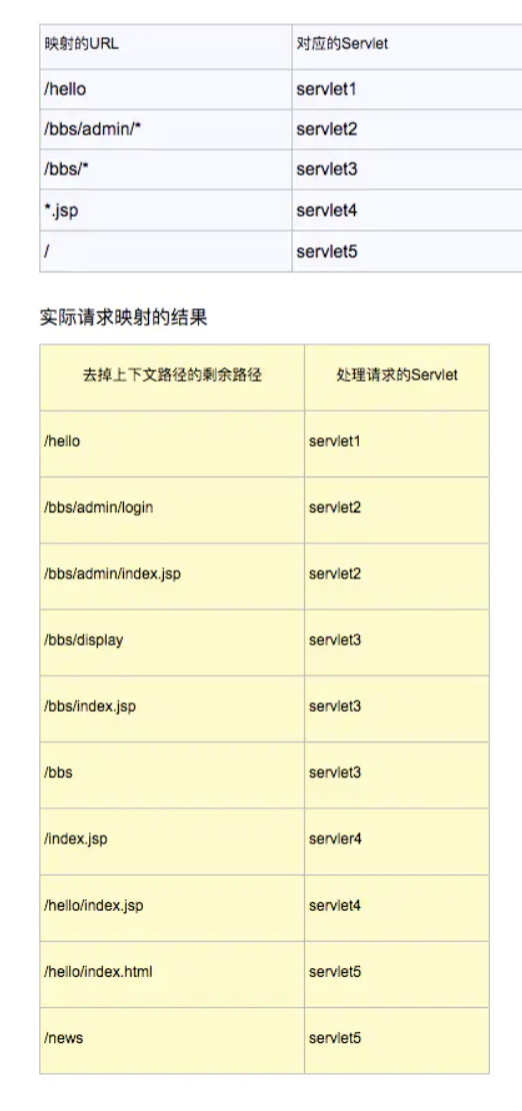tomcat关于配置servlet的url-pattern的问题详解
tomcat在配置web.xml的时候,servlet是一个比较重要的问题,在这里讨论一下servlet中的几个痛点
- servlet url-pattern的匹配问题
- url-pattern中
/和/*的区别 - url-pattern的优先级问题
- 根路径
/的匹配问题
1 servlet url-pattern的匹配问题
url-pattern有三种匹配模式,分别是路径匹配、精确匹配、后缀匹配
1.1 精确匹配
<url-pattern>中配置的项必须与url完全精确匹配。
代码举例👇
<servlet-mapping>
<servlet-name>MyServlet</servlet-name>
<url-pattern>/kata/detail.html</url-pattern>
<url-pattern>/demo.html</url-pattern>
<url-pattern>/table</url-pattern>
</servlet-mapping>
当在浏览器中输入如下几种url时,都会被匹配到该servlet
http://10.43.11.143/myapp/kata/detail.html
http://10.43.11.143/myapp/demo.html
http://10.43.11.143/myapp/table
注意:
http://10.43.11.143/myapp/table/ 是非法的url,不会被当作http://10.43.11.143/myapp/table识别
另外上述url后面可以跟任意的查询条件,都会被匹配,如
http://10.43.11.143/myapp/table?hello 这个请求就会被匹配到MyServlet。
1.2 路径匹配
以“/”字符开头,并以“/*”结尾的字符串用于路径匹配
代码举例👇
<servlet-mapping>
<servlet-name>MyServlet</servlet-name>
<url-pattern>/user/*</url-pattern>
</servlet-mapping>
路径以/user/开始,后面的路径可以任意。比如下面的url都会被匹配。
http://localhost:8080/appDemo/user/users.html
http://localhost:8080/appDemo/user/addUser.action
http://localhost:8080/appDemo/user/updateUser.actionl
1.3 后缀匹配
以“*.”开头的字符串被用于后缀匹配
代码举例👇
<servlet-mapping>
<servlet-name>MyServlet</servlet-name>
<url-pattern>*.jsp</url-pattern>
<url-pattern>*.action</url-pattern>
</servlet-mapping>
则任何扩展名为jsp或action的url请求都会匹配,比如下面的url都会被匹配
http://localhost:8080/appDemo/user/users.jsp
http://localhost:8080/appDemo/toHome.action
注意:路径和后缀匹配无法同时设置
注意:路径和扩展名匹配无法同时设置,比如下面的三个
都是非法的,如果设置,启动tomcat服务器会报错。
<url-pattern>/kata/*.jsp</url-pattern>
<url-pattern>/*.jsp</url-pattern>
<url-pattern>he*.jsp</url-pattern>
几个实例👇,不明白请看本文第三章

2 url-pattern中/和/*的区别
<url-pattern>/</url-pattern>
<url-pattern>/*</url-pattern>
先说/*,/*相对来讲比较好理解,它是路径匹配的一种,从范围上来讲,它是范围最广的路径匹配,所有的请求都符合它的要求,从精度上来讲,它是精度最低的路径匹配(注意!我说的是路径匹配),路径匹配的优先级是从长到短的(具体请看本文第三章),所以说它是精度最低的路径匹配。很多博客中说它的特点是匹配*.jsp,这不是废话吗? /*本身就是路径匹配,它当然可以匹配*.jsp。
再说/,/是匹配优先级最低的匹配,当一个url和所有的url-pattern匹配都不合适的时候,这个url就会走/匹配,根本就没有什么*.jsp的限制,大家之所以产生了(客观上也确实是这样)/不会匹配*.jsp但是/*会匹配*.jsp的原因是在tomcat/conf/web.xml里面单独配置了*.jsp的配置,具体请看本文第三章
3 url-pattern的优先级问题
当一个url与多个servlet的匹配规则可以匹配时,则按照 “ 精确路径 > 最长路径>后缀匹配”这样的优先级匹配到对应的servlet。

例1:比如servletA 的url-pattern为 /test,servletB的url-pattern为 /* ,这个时候,如果我访问的url为http://localhost/test ,这个时候容器就会先进行精确路径匹配,发现/test正好被servletA精确匹配,那么就去调用servletA,不会去管servletB。
例2:比如servletA的url-pattern为/test/,而servletB的url-pattern为/test/a/,此时访问http://localhost/test/a时,容器会选择路径最长的servlet来匹配,也就是这里的servletB。
例3: 比如servletA的url-pattern:*.action ,servletB的url-pattern为 / *,这个时候,如果我访问的url为http://localhost/test.action,这个时候容器就会优先进行路径匹配,而不是去匹配扩展名,这样就去调用servletB。

那么就产生了一个疑问。为什么/*会匹配到 *.jsp,但是/匹配不到 *.jsp呢
原因很简单,在tomcat/conf/web.xml里面会有如下配置
<servlet-mapping>
<servlet-name>default</servlet-name>
<url-pattern>/</url-pattern>
</servlet-mapping>
<!-- The mappings for the JSP servlet -->
<servlet-mapping>
<servlet-name>jsp</servlet-name>
<url-pattern>*.jsp</url-pattern>
<url-pattern>*.jspx</url-pattern>
</servlet-mapping>
👆可以清楚地看到 *.jsp作为名为jsp的servlet的后缀匹配,/*是路径匹配,其优先级高于后缀匹配,所以能匹配到后缀为jsp的文件。而/是级别最低的匹配,其级别低于后缀匹配,所以jsp文件不会被url-pattern为/的匹配到。
4 根路径/的匹配问题
大家应该会注意到一个问题,就是当url-pattern为/*的时候访问http://localhost:8080/会404,但是访问http://localhost:8080/index.html却没有问题(当然前提是在spring容器里面配置了<mvc:default-servlet-handler/>)。当url-pattern为/时,http://localhost:8080/ 会自动转发到 http://localhost:8080/index.html 而不会404。原因是什么呢?
首先,我们必须要明确,一个网址的根目录即/(比如http://localhost:8080/)到底意味着什么?经过实验发现/是很特殊的,它会被url-pattern为/*的匹配,但他不会被url-pattern为/匹配。
在tomcat中,/默认是属于会被defaultservlet匹配,但是其优先级低于路径匹配,所以当某一个servlet的url-pattern为/*时,/就会被这个servlet匹配,从而不被defaultservlet匹配。
在tomcat源代码中找到如下片段可以佐证我的看法👇
<!-- ==================== Default Welcome File List ===================== -->
<!-- When a request URI refers to a directory, the default servlet looks -->
<!-- for a "welcome file" within that directory and, if present, to the -->
<!-- corresponding resource URI for display. -->
<!-- If no welcome files are present, the default servlet either serves a -->
<!-- directory listing (see default servlet configuration on how to -->
<!-- customize) or returns a 404 status, depending on the value of the -->
<!-- listings setting. -->
<!-- -->
<!-- If you define welcome files in your own application's web.xml -->
<!-- deployment descriptor, that list *replaces* the list configured -->
<!-- here, so be sure to include any of the default values that you wish -->
<!-- to use within your application. -->
👆上面是讲 Welcome File List的,即/路径会被默认转发到Welcome File List中规定的网页,即初始页。我翻译一下上面的一部分,具体的可以谷歌翻译,翻译👉
翻译👇
当请求URI指向目录时,默认servlet在该目录中查找“欢迎文件”,如果存在,则在相应的资源URI中查找以进行显示。如果不存在欢迎文件,则默认servlet会提供目录列表(请参阅默认servlet配置中的有关如何自定义的内容)或返回404状态,具体取决于列表设置的值
/会重定向到欢迎页面的原因是Welcome File List的存在,Welcome File List发挥效果的前提是/必须被defaultservlet匹配。当某一个servlet的url-pattern为/*时,/就会被这个servlet匹配,从而不被defaultservlet匹配。所以只有在自己定义的servlet的url-pattern为/时,http://localhost:8080/ 会自动转发到 http://localhost:8080/index.html 而不会404


